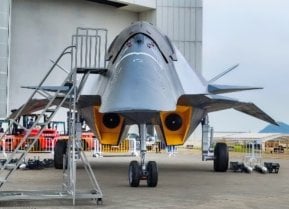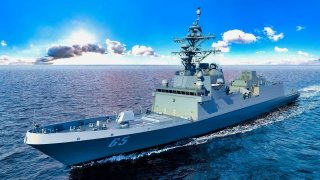Constellation-Class: 5 Reasons This New Navy Frigate Is a Nightmare
The U.S. Navy's Constellation-class frigates face significant obstacles that threaten their viability. From design alterations adding weight and cost to failing shipyards unable to meet production demands, the program is plagued by inefficiencies.
What You Need to Know: The U.S. Navy's Constellation-class frigates face significant obstacles that threaten their viability. From design alterations adding weight and cost to failing shipyards unable to meet production demands, the program is plagued by inefficiencies.

-Bureaucratic mismanagement and a lack of coherent strategic planning exacerbate the situation, questioning the Navy's focus on surface warships amid evolving threats like A2/AD and unmanned systems.
-With a 40% cost overrun and outdated acquisition processes, the Constellation-class risks becoming another costly failure in U.S. naval development.
The Top 5 Reasons Why the Constellation-class Frigates 'Will Never Sail'
We have a problem in the United States Navy. They can’t seem to build warships anymore. There’s a massive shipyard crisis afflicting this country. On top of that, even before the ships are to be built at the broken shipyards, the entire acquisitions process at the Pentagon is a bureaucratic nightmare. We can all think of several major examples from just the last 30 years where the Navy has failed in its basic mission to create and maintain a viable fleet.
From the Zumwalt-class destroyer to the Littoral Combat Ship (LCS), the Navy routinely overpromises and underdelivers on its sales pitches for new platforms.
The new Constellation-class frigate is no different. Intended to replace the Oliver Hazard Perry-class frigatesthat have all aged out, the Navy wanted to make their next frigate more streamlined, modern, and interoperable with European warships. Hence why the Navy went with an Italian shipbuilding firm, Fincantieri Marinette Marine (FREMM). Unfortunately, it’s been a slow-rolling disaster from the moment after the contracts were signed all the way to the point at which the steel for the ship’s hulls were cut.
Now, the Constellation-class is 40 percent over budget and not up to the Navy’s rigorous building requirements. Here are the top five reasons for why the Constellation-class frigate will fail (from least to greatest):
5. The Navy Changed the Design
Blame it on a cultural misunderstanding if you want (the Navy certainly does). But after the contracts with Fincantieri were signed and the specifications of the new frigate were agreed upon, Naval Sea Systems Command (NAVSEA), along with its subcontractors at Gibbs & Cox, “began to make major changes to the FREMM parent design,” according to NavyLookout.com.

The Navy wanted to make the warships 23.6 feet longer to “accommodate larger diesel generators to support future equipment fit and give an increase in speed to allow the ships to keep up with carrier battle groups steaming at 30+ knots.” The Navy also added space for 32 Mk41 Vertical Launch System (VLS) cells and “the bow sonar was removed to improve speed and seakeeping.” In all, the Americans added a whipping “300 tons of weight” to the European built Constellation-class frigate.
Now, the warship is too heavy for its own good and it will not be an effective American surface warship as a result. Oh, and since the steel for the hulls were already cut before the Navy decided to radically alter the design of the warship, it’s adding substantially to the cost.
4. The Cost is Absurdly High (Even for Military Standards)
This brings us to the next issue for why the Constellation-class frigate will never see the light of day. That’s the onerous cost. You see, the boat was pitched to Congress as a vital platform that would be affordable. That entire pitch is now completely irrelevant. Costs have exploded with the latest price for each individual warship of this new class coming in at around $1.6 billion. That’s a 40 percent increase from the original estimate. Therefore, the original order would have to either be scaled down to meet the new higher price, or the taxpayer would have to eat the cost.
One of the biggest problems affecting every branch of the United States Armed Forces is that the cost of these legacy programs is too high. Americans cannot—and increasingly will not—support such elephantine defense budgets while the cost of eggs at the grocery store is at all-time highs. Plus, there are real diminishing returnswith the kind of platforms the services, notably the Navy and Air Force, are investing in.
The systems are too complex, hard and expensive to build, and costly to maintain.
Should these systems be used in a war—a real great power conflict—and be lost, the burden on the US military and taxpayer would be so great, we might simply be unable to maintain the surface warfare fleet in any meaningful way.
3. America’s Failing Shipyards
Another massive complication for the Navy is the fact that its once vaunted shipyards are a sclerotic mess. A shadow of their former glory, the shipyards cannot keep up with current demand, let alone the increased demand of building new, complex warships to meet a global threat environment that is more contested than ever before. Fincantieri Marinette Marine Shipyard may be an Italian firm, but they have facilities in the United States.
Since the COVID-19 pandemic, these facilities have languished under the weight of broken supply chains and massively disrupted labor markets. A perfect storm of bad decisions, incompetence, and poor infrastructure have all led to the problems of the Constellation-class. Even if the Constellation had no problems with its development, it is doubtful that the program would ever come in on (or under) budget or time.
2. Bureaucracy Kills
The mentality of the Pentagon’s acquisitions arm is what’s killing this project. That is unlikely to change, no matter who is president or which party runs Congress. It’s the bureaucracy that has created all manner of rules, regulations, and requirements that are constantly in flux and risk railroading the program.
The cognitive dissonance exhibited by program managers is staggering. After all, they want a lighter, more maneuverable warship but one that has overwhelming firepower and plenty of crew protections.
Clearly, no one in the acquisitions arm of the Pentagon has taken a basic economics course and learned the timeless lessons of scarcity and tradeoffs. And why would they have? For the last 30 years, since the fall of the Soviet Union, the US government has lavished money upon the Pentagon while requiring little—if any—maintaining of economic standards.
Those days are over, though. Failure to adapt to the new environment of scarcity and trade-offs will kill this program and any other program.
1. Lack of Coherent Strategy
They say that the strategy should make the weapon. Sadly, in modern America, it’s the other way. Why does the United States need another frigate? Or more surface warships for that matter?
Perhaps it’s a radical notion on my part but with the advent of cheaper anti-access/area-denial (A2/AD) and unmanned underwater vehicles (UUVs) makes the massive investments of finite time and resources into costly systems like the Constellation-class frigate wasteful, to say the least.
If the United States figured out what it was actually trying to achieve on the world stage and married ends-ways-means together, they would find their arsenals more fully stocked, affordable, and their military capable. Until that day comes, though, the Americans will continue wasting time and money on platforms they don’t really need.
About the Author:
Brandon J. Weichert, a National Interest national security analyst, is a former Congressional staffer and geopolitical analyst who is a contributor at The Washington Times, the Asia Times, and The-Pipeline. He is the author of Winning Space: How America Remains a Superpower, Biohacked: China’s Race to Control Life, and The Shadow War: Iran’s Quest for Supremacy. His next book, A Disaster of Our Own Making: How the West Lost Ukraine, is available for purchase wherever books are sold. Weichert can be followed via Twitter @WeTheBrandon.
Image Credit: Creative Commons.


